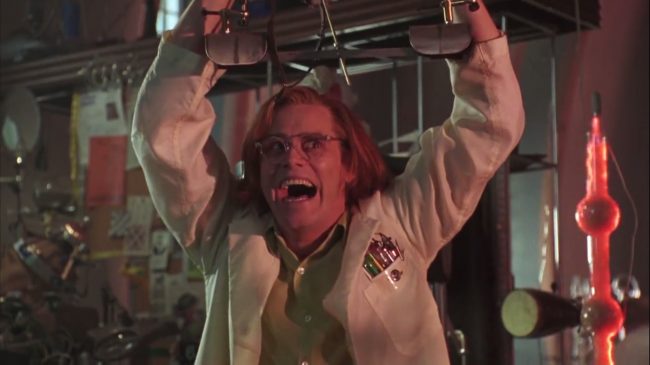
‘Batman Forever’ (1995) and the Brain Drain Moment
Batman faces his biggest challenge yet with deadly villains, Two-Face and The Riddler, joining forces to take over Gotham in hopes of finally unmasking and defeating the famed Caped Crusader.
The third installment in the Batman franchise is generally regarded as the turning point in the once popular series with critics and audiences both finding fault with the more cartoonish approach to the Dark Knight. Directed by Joel Schumacher and produced by Tim Burton, Batman Forever saw an entirely revised vision of the superhero and the world he lives in. Michael Keaton, who had donned the cape and cowl for two films did not return, leaving the role open for at-the-time Hollywood hunk and Box Office draw, Val Kilmer to squeeze into the rubber suit. While his chin certainly looks great in the outfit, there is a detachment to the role that doesn’t quite resonant well, leaving the tormented Bruce Wayne less impactful. Cold and emotionless, there is little humanity in the performance that doesn’t capture the darkness famously shrouding the character. Still, as the Batman, Vilmer is certainly passable and even has a few good moments, though the script often lets him down. His love interest, Dr. Chase Meridian (Nicole Kidman) is a huge letdown though, a dull and painfully one-dimensional character that brings very little to the story other than someone for Batman to save. Better off are the villains, with a well-cast Tommy Lee Jones playing the doomed Harvey Dent, the district attorney scarred for life, approaching every situation as a game of heads or tails. Jones lends a nice madness to the role and while it is something some might call a blemish on his stellar career, it remains a fun, twisted part that he embraces with perfection. Then there is Jim Carrey. At the very height of his stratospheric rise to massive stardom, Carrey gets to play a bad guy and some might say it is inspired casting as the rubbery-faced comic is practically a cartoon already. Stripping away any potential legitimacy of the previous Batman movies, Carrey’s Riddler is ripped from the comic book pages and is like an animated tornado throughout the production, which, as bad as it might sound, is actually the best part of the movie. Overall, the film is a mess of loud visuals and over-the-top set pieces but save for a rousing score by Elliot Goldenthal and a few good performances, is a mostly disappointing experience.

The Brain Drain Moment
At Wayne Enterprise’s research and development center, a nebbish scientist named Edward Nygma (Carrey) is working on a special television device that can transmit a TV signal directly into a person’s brain, producing 3D lifelike imagery for the viewer. He proposes the idea to Wayne, his idol, but Bruce turns it down, claiming it raises too many ethical questions. Angered and insulted by Wayne’s rejection, Nygma kidnaps his obnoxious supervisor (Ed Begley Jr. in an uncredited role) and ties him to a chair, strapping the absurdly ornate headset invention on his victim and forcing him to experience his creation. Nygma, wearing another headset, realizes that his device has an unexpected side effect: it literally drains brainwaves from one person and transfers them to the other, increasing the intelligence of the host. In his madness, he kills the supervisor and sets about a terrible scheme to use the machine to tap into the brainwaves of every citizen in Gotham.

Why It Matters
The success of any Batman, from comic book to television series to games to movies has always been the presence of a great villain. While Batman is a fascinating hero with much about him that has made him so popular, he is essentially nothing without a nemesis, a running theme the creators of any series is wholly aware of. Batman and The Joker have long made note of this in their famous conflicts. The Riddler is arguably the second most cherished bad guy in the long history of Batman, like The Joker, not known for strength of body, but power of mind. They are both also mad. This is the main character trait of most Batman villains and to get that right on screen is crucial. Carrey brings that madness. His kinetic gyrations and overly-exaggerated gestures really make the character stand out, firmly planting the tone and feel of the film as a comic book adaptation. While the setting and much of the production certainly captures that as well, Carrey acts like a gateway for the audience to fully embrace the new direction. Carrey wholly steals every scene he is in, taking the concept of a mad genius in a cartoon world and breaking all the borders that surround it. While he’s well-supported by Jones, he outshines him and everyone else, with a demented take on the already maniacal bad guy. In this moment, we see the metamorphosis caused by the brain drain process, a catalyst that spins him off from eccentric and inventive to comically homicidal. Carrey unleashes a wildly animated speech that precedes the coming costumed Riddler, giving us a real sense of the dramatic shift the invention creates. This is necessary in establishing the validity of both the machine he’s made and the motivation for why he moves forward with his nefarious plan. While the film is flawed on many levels, Carrey’s chilling and often funny turn as Riddler almost saves the show.

